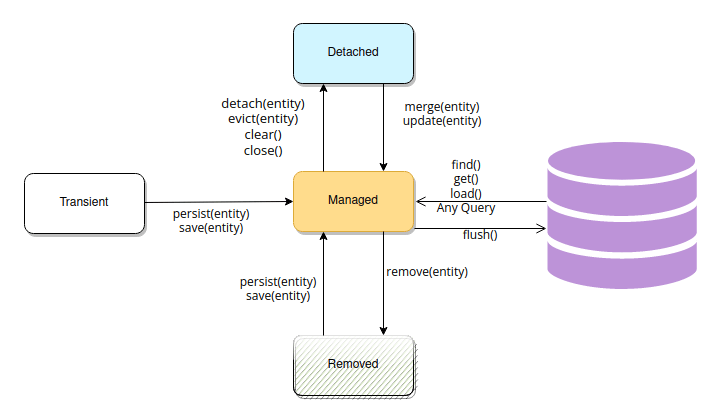This article discusses the life cycle of Entity objects in JPA Applications. Understanding the different stages that an Entity goes through is crucial for proper understanding of the JPA framework.
The JPA Entity Lifecycle refers to the stages that an entity (a Java object representing a database record) goes through during its existence in a Java Persistence API (JPA) application. There are four main stages of the entity lifecycle:
- New (Transient): When an entity is first created, it is in the “new” state. At this point, it is not yet associated with any persistence context, and therefore it has no representation in the database.
- Managed: When an entity becomes associated with a persistence context (usually through the EntityManager.persist() method), it becomes “managed”. This means that any changes made to the entity will be persisted to the database when the transaction is committed.
- Detached: If an entity is removed from the persistence context (usually through the EntityManager.detach() method), it becomes “detached”. At this point, it is no longer managed and any changes made to it will not be persisted to the database.
- Removed: When an entity is removed from the database (usually through the EntityManager.remove() method), it becomes “removed”. At this point, it is no longer managed and any changes made to it will not be persisted to the database.
The following picture summarizes the Life Cycle Stages of an Entity Bean:

It is important to understand the entity lifecycle in order to effectively use JPA in your application. For example, if you want to make changes to a detached entity and persist those changes to the database, you will need to reattach it to the persistence context first. Understanding the entity lifecycle can also help you to avoid common pitfalls and errors when working with JPA.
To understand better, we will show a practical example which uses the following Entity Class:
@Entity
@Table(name = "employees")
public class Employee {
@Id
@GeneratedValue(strategy = GenerationType.IDENTITY)
private long id;
private String name;
private String jobTitle;
// constructors, getters, and setters
}
The Transient Phase
Then, let’s see an example of Entity Bean in the Transient Phase:
Employee emp = new Employee("John Smith", "Manager");
In this example, the “emp” entity is in the transient state because it has been created but it is not yet managed by the persistence context. It is not yet associated with any database record and any changes made to it will not be persisted to the database.
The Managed Phase
Then, let’s see an example of Entity Bean in the Managed Phase:
Employee emp = new Employee("John Smith", "Manager");
// persist the employee to the database, making it a managed entity
em.persist(emp);
n this example, the employee entity is first created and then persisted to the database using the entity manager. This causes the employee to become a managed entity, attached to the persistence context.
The Detached Phase
Then, let’s see an example of Entity Bean in the Detached Phase:
Employee emp = new Employee("John Smith", "Manager");
// persist the employee to the database, making it a managed entity
em.persist(emp);
// closes the Entity Manager
em.close();
In this example, the Employee entity is initially in the new state, but after it is persisted and the EntityManager is closed, it becomes detached. Any changes made to the Employee entity while it is in the detached state will not be persisted to the database unless it is reattached to a persistence context.
The Removed Phase
Then, let’s see an example of Entity Bean in the Detached Phase:
Employee employee = em.find(Employee.class, 1L); // Find employee with ID 1 em.remove(employee); // Remove the employee from the database // At this point, the employee entity is in the removed state
In this example, we use the EntityManager to find an Employee entity with an ID of 1 and then remove it from the database using the remove() method. This causes the entity to enter the removed state. It is important to note that the entity will not actually be deleted from the database until the current transaction is committed.